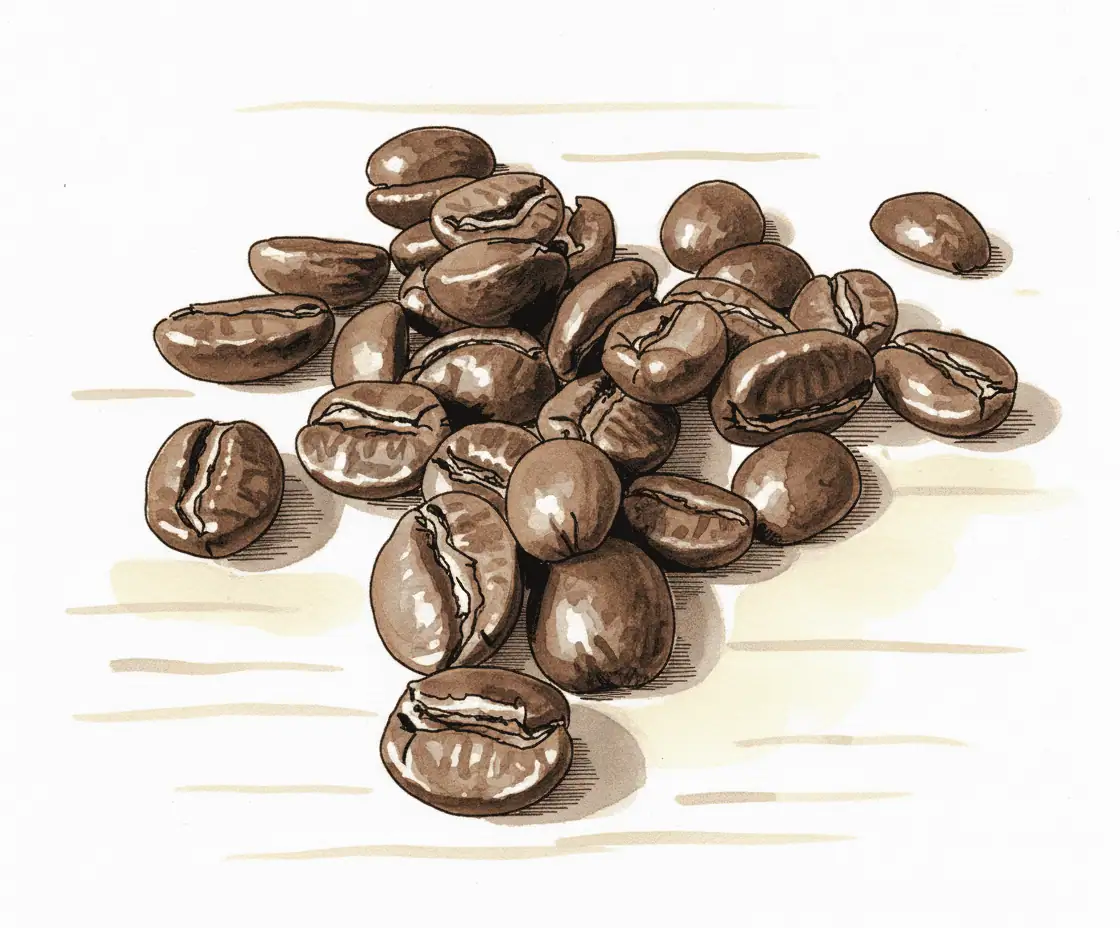High-Altitude Coffee
At high altitudes (above 1500 meters), coffee cherries ripen more slowly, resulting in denser beans with pronounced aromas. The lower temperature and thinner air foster a complex flavor profile, often characterized by high acidity and fruity, floral, or wine-like notes. Regions such as Ethiopia and parts of Latin America are known for their high-altitude coffees, which are prized for their refined and sparkling character.
High‑altitude coffee beans

Brazil & Colombia – Five Points Blend
Five Points Blend van Five Ways Coffee koppelt Braziliaanse zoetheid aan Colombiaanse frisheid. De blend brengt framboos, melkchocolade en een vleug cacao samen in een levendige, schone kop. Natural en washed loten geven tegelijk body en helderheid, wat zorgt voor balans en een lange zoete afdronk.Deze koffie is ontwikkeld voor espresso en presteert stabiel thuis…

Brazil Santos
Boot Koffie presenteert Brazil Santos uit Carmo de Minas, natural verwerkte Yellow Catuai. Verwacht chocolade, geroosterde noten, bruine suiker en zacht steenfruit in balans. De body is romig, de aciditeit vriendelijk, de afdronk melkchocolade en amandel. Dit profiel is ontwikkeld voor espresso en blijft overeind in melkdranken.Zetadvies van de brander, geschikt voor espressomachine, espressokan en…

Brazil Santos
Brazil Santos van OVErHOOP komt uit meerdere kleine percelen rond Santos. De natural verwerking geeft een zoete basis en romige body. De branding benadrukt zoetheid en body, waardoor espresso krachtig smaakt en melkdranken dessertachtig worden. In filter blijft de frisse rinse duidelijk, met een schone, toegankelijke finish. Verwacht tonen van noten, melkchocolade en karamel, met…

Brazilië | Ellen Fontana
Deze single origin uit Socorro São Paulo komt van Fazenda Fronteira, geleid door Ellen Fontana. Henry’s Coffee brandde de boon als espresso roast, gericht op zoetheid en helder rood fruit. In de kop proef je tropisch fruit, gedroogd fruit en melkchocolade, met een zachte zuurgraad en lange, romige afdronk. De partij is natural verwerkt en…

Brazilië Colombia blend
Deze blend verenigt Cerrado zoetheid met Huila frisheid voor een ronde, levendige espresso. Verwacht pure chocolade, hazelnoot en karamel, gelift door een vleug groene appel. De Braziliaanse pulped natural geeft body, de gewassen Colombia zorgt voor helderheid.Espresso recept 18 g in, 40 g uit, ca. 24 s.Beste in melkdranken dankzij volle body en cacao.SCA score…

Brooklyn
Brooklyn is een espresso blend met 90 procent Brazilië en 10 procent Geisha uit Panama. De bonen komen van Fazenda JS in Mata de Minas en Finca Santa Teresa in Volcán. De branding richt zich op balans, vermoedelijk medium dark, met behoud van delicate aroma’s. Verwacht tonen van gekonfijte sinaasappel, praline en romigheid, met een…

Brotherhood
Brotherhood is a specialty blend from BeanBrothers, sourced from Nicaragua, Brazil, and Honduras, put together by Bruno, Silvio, and Omar. At Stadsbranderij Eindhoven it is freshly roasted weekly on a Giesen, with a medium roast that preserves balance and brightness. Expect notes of red fruit, milk chocolate, and cane sugar, with a clean finish. All components are naturally processed…

Buena Vista
Buena Vista is een lichte filterkoffie uit Huila in Colombia, rechtstreeks ingekocht bij Maricela Joven Penagos. De microlot wordt gewassen verwerkt en op 1750 meter gedroogd onder marquesinas, wat zorgt voor een schone, heldere kop. Verwacht romige hazelnoot, ahornsiroop en een frisse kersenafdronk, mooi in balans. De variëteiten Pink Bourbon en Papayo geven een verfijnd,…

Burundi Butihinda
Burundi Butihinda van Blanche Dael komt uit Muyinga, verwerkt als washed Bourbon. Verwacht een fruitig zoete kop met laurier, zoethout en lichte karamel. De aciditeit is helder, de body medium, de afdronk lang en kruidig. SCA score 84,5 bevestigt de consistente kwaliteit. Deze single origin is transparant in smaaklagen en nodigt uit tot nauwkeurige extractie.V60,…

Butter My Pineapple
Butter My Pineapple is een expressieve omni roast van Sprout Coffee. De boon komt uit Lalesa in Gedeb, Ethiopie, op 2150 tot 2200 meter. Slow Dry Natural geeft gelaagd fruit, met florale aanzet, gedroogde ananas en romige butterscotch. De zuurgraad is rijp, de nasmaak lang en zoet. Zoek helderheid in filter en balans in espresso,…

Café Logico
De Maalwerk Café Logico bonen bieden een rijke smaakervaring met tonen van donkere chocolade, karamel en een subtiele citruszest. Deze arabica’s, gecombineerd met robuustabonen, worden nat en droog verwerkt om een complex smaakprofiel te creëren. Door de langzame branding van Maalwerk Koffie blijven de rijke smaken behouden. Ze zijn ideaal voor verschillende zetmethoden zoals V60,…

Cafeïne arm
Zoek je een avondvriendelijke kop zonder decaf bijsmaak? Smit en Dorlas Cafeïne arm is een zorgvuldig gebalanceerde melange van hoogland Arabica, ontwikkeld door UCC Coffee Benelux. De koffie bevat circa 0,76 procent cafeïne en vermijdt chemische decafeïnering, waardoor het aroma behouden blijft. De branding is iets lichter voor een mild karakter met heldere geur, nette…

Cafeïne arm
Zoek je een zachte decaf met betrouwbare herkomst en een schone kop? Smit en Dorlas Cafeïne arm is een Rainforest Alliance blend van hoogland Arabica. De cafeïne wordt zonder chemische oplosmiddelen verwijderd, wat het aromaprofiel bewaart. Verwacht een milde body, nootachtige en cacaoachtige tonen, en een korte, nette afdronk. Ideaal voor een late espresso of…

Cafeïnevrije Colombia (Future Proof)
Deze cafeinevrije Colombiaanse koffie komt uit de hooglanden van Tolima en is een single origin van Supremo kwaliteit. De medium roast in kleine batches behoudt aroma en balans, met tonen van noot en donkere chocolade en een medium body. De CO2 decafeinatie verwijdert cafeine zacht en milieuvriendelijk, zonder chemische oplosmiddelen en met minder dan 0,1…

Caimo Collective
Caimo Collective van Keen Coffee komt uit Pitalito Huila en wordt verbouwd door een collectief van kleine boeren. De koffie is licht gebrand als Colombiaanse espresso met een heldere, fruitige structuur. Verwacht proefnotities van gedroogde abrikoos, guave en rijke honingzoetheid, gebalanceerd en soepel. De bonen worden gewassen verwerkt met zorgvuldige controle in elke fase, wat…

Canastra
Canastra is de huisblend van Man met de Baard. Braziliaanse Yellow Bourbon wordt gemengd met Ethiopië Sidamo en Oost Timor. De branding is middelmatig en inzetbaar voor espresso en filter. Verwerkingen lopen van gewassen tot pulped natural, wat zoetheid, helderheid en body verenigt.Smaken: romige karamel, zachte chocolade, citrus, florale hintsAfdronk: lang, aards en licht zilt,…
High Altitude (above 1500 meters)
Welcome to the world of high-altitude coffee! When you think of beans grown above 1500 meters, words like “refined,” “complex,” and “vibrant” often come to mind. But why exactly? In this article, we’ll dive into the effects of high altitudes on your espresso, the chemical composition of the beans, processing methods, and much more.
How altitude affects espresso flavor
At high altitudes, coffee cherries mature more slowly. This gradual ripening process allows sugars and acids in the fruit to develop over time, giving the beans ample opportunity to build a full range of flavors. When you use these beans for espresso, you’ll often taste a refined acidity and floral or fruity characteristics—think subtle citrus or berry aromas with a bright, almost “sparkling” quality. If you enjoy a delicate espresso, high-altitude beans are an excellent choice.
Chemical composition: density, sugars, and acids
Because the air is thinner and cooler at higher elevations, coffee trees receive less oxygen and grow at a slower pace. This results in denser beans that often exhibit higher acidity. The sugars develop more gradually, and the extended ripening contributes to a complex flavor structure. You end up with a bean that balances sweetness and complexity, translating into a lively cup of coffee. The increased density also impacts roasting profiles: roasters usually take extra care to highlight all those nuanced flavors.
Processing methods at high altitude
Thanks to the cooler, sometimes more humid climate, some coffee farmers opt for processing techniques that emphasize their beans’ unique characteristics. In many high-altitude regions, the washed method is especially popular, as it accentuates fruity and floral notes. Removing the pulp and mucilage under carefully controlled conditions allows any impurities to wash away, leaving a clean, pure flavor. There’s also some experimentation with natural and honey processes in these regions, though washed processing is often the standard for maintaining clarity.
Climate and microclimate
High-altitude environments have unique weather conditions: cooler nights, milder days, and often more rainfall. In some places, mist clings to the mountainsides, creating microclimates that can vary even from one slope to the next. This contributes to the slow ripening of cherries and the development of complex aromas. On the flip side, coffee farmers face challenges like fungal diseases in damp conditions, but the reward is a flavor profile cherished worldwide.
Yield and resilience
Growing coffee at 1500 meters or higher isn’t easy. The trees often produce fewer cherries because the plants expend more energy just to survive in cooler temperatures. Still, the beans command a premium for their pronounced quality and distinctive taste. Many farmers form cooperatives to share knowledge about cultivating coffee under these challenging conditions, employing innovative irrigation methods or using shade trees to protect their coffee plants.
Choosing coffee varieties
Not all coffee plants thrive at 2000 meters. Farmers often select varieties that can handle the cold and resist diseases, such as certain Arabica strains (like Bourbon, Typica, or Geisha). These varieties are known for their potential to develop subtle flavor nuances—a perfect match for the special circumstances high altitudes provide.
All in all, coffee from high altitudes isn’t just any cup of joe. Expect floral notes, a lively acidity, and refined aromas that will delight anyone seeking a bright and complex coffee experience.
